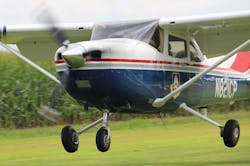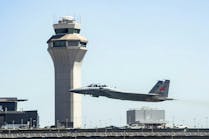CAP Exceeds 100,000 Flying Hours in Fiscal 2017
MAXWELL AIR FORCE, Ala. — For the second straight year, Civil Air Patrol has amassed 100,000 flying hours for its 560-plane fleet, which is recognized as one of the largest assemblages of single-engine aircraft in the world.
John Desmarais, Civil Air Patrol’s director of operations, said the milestone was met during a flight Thursday morning in Puerto Rico, in which a CAP aircrew was collecting imagery of the Hurricane Maria damage throughout the island.
“I really didn’t think we were going to make it to 100,000 flying hours a month ago,” said Desmarais, who had set the lofty goal for the 2017 fiscal year, which ends on Saturday.
Desmarais said an updraft of Air Force-assigned disaster relief missions in the wake of recent hurricanes in Texas, Louisiana, Florida, Puerto Rico and the Virgin Islands contributed greatly to Civil Air Patrol reaching the 100,000-mark again. In fiscal 2016, CAP flying hours totaled 104,525 hours — the highest in the last five years.
Disaster relief flights have totaled 2,830 more hours this year than last, Desmarais said. He cited dozens of disaster relief missions and other federal, state and local agency support missions across the country, ranging from the massive rainfall that accompanied Hurricane Matthew in the fall of 2016 to recent support for the responses to Hurricane Harvey, which also wrought historic flooding, and Hurricanes Irma and Maria. Harvey, Irma and Maria have made landfall during the past month, prompting CAP aircrews to take to the skies in support of emergency responders.
New National Commander Maj. Gen. Mark Smith, who took over at the 2017 National Conference during the organization’s response to Hurricane Harvey, said he’s was not surprised that CAP’s recent disaster relief flights help put the organization over the 100,000-mark for the year.
“Our aircrews are the best, always training and always ready to serve,” said Smith. “And CAP’s large fleet of Cessna aircraft provides these professionally trained aircrews with the perfect platform to provide quick and reliable reconnaissance to the Air Force as well as emergency responders on the ground.”
In addition to the uptick in disaster relief flying hours in fiscal 2017, CAP also saw an increase in homeland security missions, which included its more than 600 MQ-9 remote piloted aircraft escort flights in support of the Air National Guard’s 174th Attack Wing. As part of the U.S. Air Force Reaper Training Program for pilots and sensor operators, CAP aircrews accompanied MQ-9 Reapers to and from Military Restricted Airspace in central New York state for training exercises. This support has helped save taxpayers over $1 million and has increased MQ-9 training by 25 percent.
“CAP is always looking for new opportunities for our members to fly in support of their communities across the country,” said Desmarais.
Smith agreed, adding, “We don’t often know when our next mission will come, so we must be prepared at all times.”
Civil Air Patrol, the longtime all-volunteer U.S. Air Force auxiliary, is the newest member of the Air Force’s Total Force. In this role, CAP operates a fleet of 560 aircraft, performs about 90 percent of continental U.S. inland search and rescue missions as tasked by the Air Force Rescue Coordination Center and is credited by the AFRCC with saving an average of 80 lives annually. CAP’s 57,000 members also perform homeland security, disaster relief and drug interdiction missions at the request of federal, state and local agencies. CAP also plays a leading role in aerospace/STEM education, and its members serve as mentors to 24,000 young people participating in CAP’s Cadet Programs. Visit www.GoCivilAirPatrol.com for more information.



